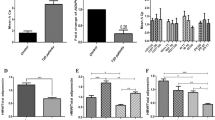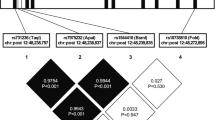Abstract
Context:
The sterol regulatory element-binding protein-1c (SREBP-1c) is a transcription factor involved in the regulation of lipid and glucose metabolism and has been implicated in the pathophysiology of type 2 diabetes mellitus (T2DM).
Objective:
We aimed to confirm associations of the SREBF-1 gene with T2DM in an Austrian population and to study possible associations with diabetes-related quantitative traits.
Design, settings and participants:
We genotyped a diabetic cohort (n=446) along with a control group (n=1524) for a common C/G variation that is located in exon 18c (rs2297508) and has been associated with obesity and T2DM in French populations.
Main outcome measures:
Body mass index (BMI), indices of insulin sensitivity and β-cell function, plasma adiponectin, T2DM and single-nucleotide polymorphism rs2297508.
Results:
Genotype distributions associated with rs2297508 differed by T2DM status (P=0.0045), but not by BMI. The variant G allele was associated with a modest, but significant, increase in the prevalence of T2DM after adjustment for age, sex and BMI (G/G: odds ratios (OR) (95% confidence intervals)=1.45 (0.99–2.11) and G/C: OR=1.37 (1.04–1.81)). In a cross-sectional population of non-diabetic subjects, associations of rs2297508 genotypes with plasma adiponectin levels adjusted for age, sex and BMI (P=0.0017) were observed in that the risk G/G genotype displayed the lowest adiponectin levels.
Conclusions:
We observed associations of rs2297508 with T2DM prevalence and plasma adiponectin. SREBP-1c has been implicated in the regulation of adiponectin gene expression. Our results therefore raise the possibility that sequence variations at the SREBF-1 gene locus might contribute to T2DM risk, at least in part, by altering circulating adiponectin levels.
This is a preview of subscription content, access via your institution
Access options
Subscribe to this journal
Receive 12 print issues and online access
$259.00 per year
only $21.58 per issue
Buy this article
- Purchase on Springer Link
- Instant access to full article PDF
Prices may be subject to local taxes which are calculated during checkout
Similar content being viewed by others
Accession codes
References
Brownlee M . Biochemistry and molecular cell biology of diabetic complications. Nature 2001; 414: 813–820.
Horton JD, Goldstein JL, Brown MS . SREBPs: activators of the complete program of cholesterol and fatty acid synthesis in the liver. J Clin Invest 2002; 109: 1125–1131.
Im SS, Kang SY, Kim SY, Kim HI, Kim JW, Kim KS et al. Glucose-stimulated upregulation of GLUT2 gene is mediated by sterol response element-binding protein-1c in the hepatocytes. Diabetes 2005; 54: 1684–1691.
Foretz M, Guichard C, Ferre P, Foufelle F . Sterol regulatory element binding protein-1c is a major mediator of insulin action on the hepatic expression of glucokinase and lipogenesis-related genes. Proc Natl Acad Sci USA 1999; 96: 12737–12742.
Guillet-Deniau I, Mieulet V, Le Lay S, Achoury Y, Carre D, Girard J et al. Sterol regulatory element binding protein-1c expression and action in rat muscles: insulin-like effects on the control of glycolytic and lipogenic enzymes and UCP3 gene expression. Diabetes 2002; 51: 1722–1728.
Yamashita T, Eto K, Okazaki Y, Yamashita S, Yamauchi T, Sekine N et al. Role of uncoupling protein-2 up-regulation and triglyceride accumulation in impaired glucose-stimulated insulin secretion in a beta-cell lipotoxicity model overexpressing sterol regulatory element-binding protein-1c. Endocrinology 2004; 145: 3566–3577.
Oberkofler H, Fukushima N, Esterbauer H, Krempler F, Patsch W . Sterol regulatory element binding proteins: relationship of adipose tissue gene expression with obesity in humans. Biochim Biophys Acta 2002; 1575: 75–81.
Sewter C, Berger D, Considine RV, Medina G, Rochford J, Ciaraldi T et al. Human obesity and type 2 diabetes are associated with alterations in SREBP1 isoform expression that are reproduced ex vivo by tumor necrosis factor-alpha. Diabetes 2002; 51: 1035–1041.
Demenais F, Kanninen T, Lindgren CM, Wiltshire S, Gaget S, Dandrieaux C et al. A meta-analysis of four European genome screens (GIFT Consortium) shows evidence for a novel region on chromosome 17p11.2-q22 linked to type 2 diabetes. Hum Mol Genet 2003; 12: 1865–1873.
Eberle D, Clement K, Meyre D, Sahbatou M, Vaxillaire M, Le Gall A et al. SREBF-1 gene polymorphisms are associated with obesity and type 2 diabetes in French obese and diabetic cohorts. Diabetes 2004; 53: 2153–2157.
Laudes M, Barroso I, Luan J, Soos MA, Yeo G, Meirhaeghe A et al. Genetic variants in human sterol regulatory element binding protein-1c in syndromes of severe insulin resistance and type 2 diabetes. Diabetes 2004; 53: 842–846.
Oberkofler H, Linnemayr V, Weitgasser R, Klein K, Xie M, Iglseder B et al. Complex haplotypes of the PGC-1alpha gene are associated with carbohydrate metabolism and type 2 diabetes. Diabetes 2004; 53: 1385–1393.
Nagata R, Nishio Y, Sekine O, Nagay Y, Maeno Y, Ugi S et al. Single nucleotide polymorphism (−468 Gly to A) at the promoter region of SREBP-1c associates with genetic defect of fructose-induced hepatic lipogenesis [corrected]. J Biol Chem 2004; 279: 29031–29042.
Laaksonen R, Thelen KM, Paiva H, Matinheikki J, Vesalainen R, Janatuinen T et al. Genetic variant of the SREBF-1 gene is significantly related to cholesterol synthesis in man. Atherosclerosis 2006; 185: 206–209.
Goldfine AB, Kahn CR . Adiponectin: linking the fat cell to insulin sensitivity. Lancet 2003; 362: 1431–1432.
Seo JB, Moon HM, Noh MJ, Lee YH, Jeong HW, Yoo EJ et al. Adipocyte determination- and differentiation-dependent factor 1/sterol regulatory element-binding protein 1c regulates mouse adiponectin expression. J Biol Chem 2004; 279: 22108–22117.
Arita Y, Kihara S, Ouchi N, Takahashi M, Maeda K, Miyagawa J et al. Paradoxical decrease of an adipose-specific protein, adiponectin, in obesity. Biochem Biophys Res Commun 1999; 257: 79–83.
Faraj M, Havel PJ, Phelis S, Blank D, Sniderman AD, Cianflone K . Plasma acylation-stimulating protein, adiponectin, leptin, and ghrelin before and after weight loss induced by gastric bypass surgery in morbidly obese subjects. J Clin Endocrinol Metab 2003; 88: 1594–1602.
Yang WS, Lee WJ, Funahashi T, Tanaka S, Matsuzawa Y, Chao CL et al. Weight reduction increases plasma levels of an adipose-derived anti-inflammatory protein, adiponectin. J Clin Endocrinol Metab 2001; 86: 3815–3819.
Acknowledgements
This study was supported by grants from the Oesterreichische Nationalbank (Project No. 10678 and 10932), the Medizinische Forschungsgesellschaft Salzburg and a grant from the Land Salzburg.
Author information
Authors and Affiliations
Corresponding author
Rights and permissions
About this article
Cite this article
Felder, T., Oberkofler, H., Weitgasser, R. et al. The SREBF-1 locus is associated with type 2 diabetes and plasma adiponectin levels in a middle-aged Austrian population. Int J Obes 31, 1099–1103 (2007). https://doi.org/10.1038/sj.ijo.0803505
Received:
Revised:
Accepted:
Published:
Issue Date:
DOI: https://doi.org/10.1038/sj.ijo.0803505
Keywords
This article is cited by
-
SREBF1 gene variations modulate insulin sensitivity in response to a fish oil supplementation
Lipids in Health and Disease (2014)
-
Aberrant activation of liver X receptors impairs pancreatic beta cell function through upregulation of sterol regulatory element-binding protein 1c in mouse islets and rodent cell lines
Diabetologia (2012)



